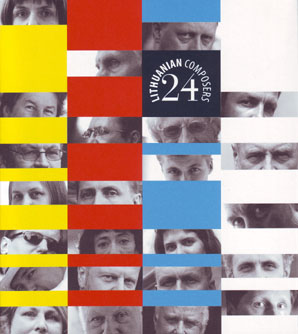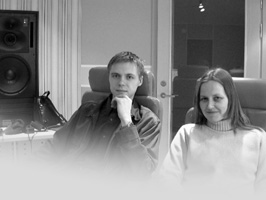Fragments from a learning process
I am a seventy-year-old Swede. When I grew up Lithuania did not exist. Not more than as a red-green-yellow symbol in the lists of maps signifying a country that had been swallowed up by the Soviet Union. At school we learned at best that the rulers of Sweden and Poland fought against each other in Lithuania in the early 17th century. Although I became a 'musicologist', a radio employee, a music journalist, an administrator and the decision-maker in charge of commissioning compositions in a public institution in neighbouring Sweden, in the spring of 1989 I still did not know anything about the music of Lithuania. For there was no such country.
But by then the Soviet empire had begun to crack. In 1989 the Swedish composer, Folke Rabe, who was also engaged in radio work, presented a portrait of his Lithuanian colleague Osvaldas Balakauskas on Swedish radio. He had met Balakauskas during the Zagreb-biennial, and told Swedish listeners about a highly interesting, intellectual composer working in a severely controlled artistic environment. In Balakauskas jazz influences and serialism met; and we learned - to my surprise - that during his years as a student in Kiev in the 1960s, as a member of a local avant-garde group he had firmly acquainted himself with Stockhausen, Boulez and Cage. However, when I met Balakauskas in 2002 he had made a slight change of course. "Music is communication and nowadays I believe it must be communication. Music should not serve as the instrument of an ideology. I see music as social interplay between people. If I play this game then I play with people." Balakauskas became the ambassador in Paris and an important teacher of composition in Vilnius.
In the news reports about the liberation of Lithuania in 1990-1991 we heard how the Lithuanians defended themselves by singing, by their folk-songs and by the forbidden Lithuanian language. There was something romantic about it. But the first president of the nation reborn, Vytautas Landsbergis, was a distinguished musicologist and pianist. This made a deep impression on me. In my country prominent culture-bearers are rarely found in the political sphere.
I renewed my contact with Lithuanian music during the ISCM World Music Days in Stockholm in October 1994. By that time Lithuania had been an independent state for a few years with its own flag and ISCM-section. And then a short but captivating, albeit repetitive and monotonous, choral work called "The Rain on Thin Glass Legs" was performed in St. Jacob's church. The composer's name was Nomeda Valančiūtė. Evidently she was a minimalist. My curiosity was roused. Her minimalism did not come from the USA and Philip Glass or Steve Reich; instead it came from Lithuanian folk-music traditions. When seven years later I made her acquaintance I learned that she was a music librarian, that, as a woman, she was afraid of writing overly feminine music and that in the mid 80s she had belonged to the "machinists". This had been a group of oppositional composers who provoked the decaying Soviet regime with defiant, frequently repetitive compositions.
At the beginning of the 21st century the gunpowder smoke from the provocations of the "machinists" seemed to have lifted. Now Lithuania was in a feverish phase of development. It was then that I had my chance to stride into Lithuanian music by virtue of the fact that I worked at the Swedish state music organisation, Rikskonserter (Concerts Sweden). After the liberation of the Baltic countries from the Soviet Union, Sweden developed a policy for the incorporation of Estonia, Latvia and Lithuania into a more western community. The area of culture, also, opened up to publicly financed campaigns. Soon after the turn of the millennium Rikskonserter joined on a wide front with Sveriges Radio (Radio Sweden) and a number of other institutions in a two-year collaboration project with Lithuania, "Musical links, Sweden Lithuania 2002-2003". Our Lithuanian partners in this collaboration were the Lithuanian Embassy in Sweden, the Ministry of Culture, the National Philharmonic Society, the Academy of Music, the Music Information and Publishing Centre and the Composers' Union. Fairly large sums of money were put into the exchange of musicians and ensembles of various sizes and representing different genres – not least, contemporary art music. The commissioning of compositions and the exchange of knowledge were also parts of the project.
|

Göran Bergendal, 24 Lithuanian Composers,
catalogue (2005)
|
As head of developments at Rikskonserter I had to handle two assignments: to establish cooperation with Lithuania in the field of contemporary art music, and to write an overview of contemporary Lithuanian art music intended for a Swedish readership. Other genres were to be reviewed in summary by other writers. Unable to summarize something of which I had no knowledge I went to Vilnius to cobble together a score of individual mini-portraits of contemporary Lithuanian composers based on listening to music and on taped interviews. When put together, the texts would at any rate provide the enquiring reader with an overview. There is no doubt that there was considerably greater competence in this area to be found in Lithuania, but the point was that Lithuanian music was to be studied by an outside observer.
I received some rapid tuition in contemporary Lithuanian music from the highly efficient music information centre. It was hardly a question of a historical retrospect. After an initial reconnoitring visit I was inundated with CDs of contemporary Lithuanian music and fragmentary information. I attended the Gaida and Jauna Muzika festivals. I listened and listened and listened. I needed to talk to these composers, all totally unknown to me, in order to hear their views on their art and to find patterns in the jumble. I made a preliminary selection of 18 to 20 composers, carefully prompted by Daiva Parulskienė, the wise woman heading the centre. One week in April was reserved for interviews in the auditorium of the composers' centre. Daiva put together a timetable for four interviews a day and summoned her composers. They came and went, replacing one another as though visiting a dentist's surgery.
This encounter with creating musical artists was a great and unique experience for me. I plunged straight down into a colourful, vibrant spectrum of music, entirely unknown to me, which to a great extent was rooted in indigenous, partly national origins. Much power and inspiration emanated from the remarkable, romantic-expressionist painter and composer Mikolajus Konstantinas Čiurlionis from the turn of the previous century, but also from the singular, repetitive "sutartinės", a folk-music type of song and – to some extent - from the movement for liberation from Soviet supremacy. I was able to visit the home of the cult figure of Lithuanian music, Bronius Kutavičius (born in 1932), a sort of national wizard, who staged myth and history in provocative musical rites to lead the Lithuanians to their roots and to strengthen their Lithuanian identity. He played for me fragments from an oratorio, soon to be completed, celebrating the 750th anniversary of the coronation of king Mindaugas, complaining, however, about the lack of documentation of coronations in days of old.
I met almost the entire "machinist generation", to which Nomeda Valančiūtė had belonged, and discovered that they had almost all been pupils of Kutavičius, the minimalist canon philosopher Rytis Mažulis, the dynamic and globally oriented Gintaras Sodeika (the theatre composer of the theatre director Oskaras Koršunovas) and the great ruffian Šarūnas Nakas, who was once told that he should do his military service in the Soviet army instead of studying at the Academy of Music.
I got to know the immediately preceding generation, referred to as the neo-romantic faction, including the chameleon Mindaugas Urbaitis, who only expresses himself in the styles of other epochs and composers, Onutė Narbutaitė, who in her great 2nd symphony spoke with both Bach and God, the "post-systematician" Algirdas Martinaitis, polemical, ecological, anti-technical, and Vidmantas Bartulis, who in his rich and overflowing work cultivates new-simplicity, naivism and religiously coloured themes.
I met older, scarred composers, who, as artists, have survived the Soviet Union – Vytautas Laurušas, Vytautas Barkauskas, Feliksas Bajoras, Jurgis Juozapaitis, and Anatolijus Šenderovas – and who have had the Warsaw autumn with Lutosławski and Penderecki as their only peephole to the wider world. And I met a number of younger composers, far too young to have suffered torment themselves as artists behind the bars of the Soviet epoch's artistic prison. They longed to come out into the world that awaited them – America, Europe, perhaps even Sweden. They yearned for modern technology, new air and new contacts.
|

Vytautas V. Jurgutis and Loreta Narvilaitė at
Visby International Centre for Composers
photo: Jesper Elén
|
This was sufficient for nineteen short portraits in a Swedish language booklet entitled "Musiken i Litauen" (Music in Lithuania), and provided me with a bolster of knowledge for discussions with Remigijus Merkelys – festival director, chairman of the composers' union and a very exciting composer – in the course of which much of the exchange programme gradually developed. This was only in part to deal with sending artists on tour in each other's countries. In cooperation with the composers' centre in the mediaeval town of Visby on the island of Gotland, a number of young Lithuanian composers were invited to work for a couple of months in its new studio for electronic music. The Lithuanian composers' union made the selection. The work consisted partly of joint projects with Gotland's woodwind quintet and Stockholm's saxophone quartet aiming at the Jauna Muzica festival in Vilnius. One of the first guests was the young composer Vytautas V. Jurgutis, whose composition – commissioned by Rikskonserter – was also to be the starting point for a portrait CD made at Rikskonserter's record company, Caprice.
Rikskonserter also commissioned music by Lithuanian composers for the Swedish contemporary ensembles that visited Lithuania – a work by Rytis Mažulis for the trio Kairos (soprano, lute and viola da gamba) and a work by Šarūnas Nakas for KammarensembleN. Nakas, too, was presently to be the subject of a portrait CD at Caprice. A particularly thrilling meeting took place between the Lithuanian Kordos-quartet and the Ars Nova-quartet in Malmö. Together they made a programme that included a septet by the Swedish composer Peter Hansen and "Melody in the Garden of Olives" for two string quartets and trumpet by Onutė Narbutaitė, a preliminary study for the second movement of the second symphony.
The interviews also yielded two one-hour programmes about Lithuanian music on Swedish radio and knowledge about Swedish music was disseminated at seminars at the House of Composers in Vilnius. In addition, tips about composers, musicians and artistic ideas were exchanged during an endless number of informal conversations.
I have no idea of what the more far-reaching effects of project collaboration of this kind might be. Two years is a short time if lasting results are to be achieved. I cannot say that Lithuanian music has made deep inroads into Swedish musical life. It does not work that easily. But the knowledge of Lithuanian music and the interest in it should be greater today than it was before and I believe that threads have been spun across the Baltic Sea which one fine day will result in new and unconventional musical experiences on both sides. And, as said before, a booklet was written in Swedish about Lithuanian music. Perhaps it was given a sort of seal of approval when the Lithuanian centre for music information expressed its intention to publish the portraits – in Lithuanian.
Translation from Swedish by John Hughes
World New Music Magazine Nr. 18


